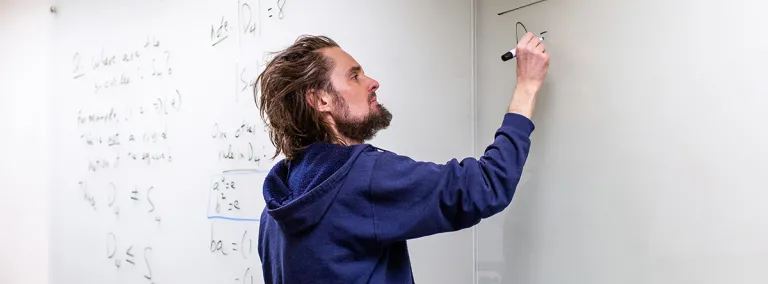Math and poetry intersect at upcoming Deep Talks
Deep Talks lecturer explores the rich tradition of mathematically-informed poetry
Mathematician-poets or poet-mathematicians—Dr. Daniel May can’t decide which they should be called. Regardless of their title, this community of math and writing devotees has a long tradition of transforming the way we view the relationship between equations and language.
“I’ve always had a personal curiosity in underlying patterns—in how mathematics informs other systems,” said May, a mathematics professor at Black Hills State University. In 2014, May published an article in the Journal of Mathematics and the Arts exploring the structure of the poem, the Rubaiyat of Omar Kiam, using graph theory. With this publication, May was introduced to a unique academic community in a new way.
“The Journal published a special issue on the overlap of math and poetry,” said May. “Publishing in it opened me up to this community where a lot of people are digging into these very subjects, publishing papers and writing books. I’ve enjoyed learning from them and sharing ideas since.”
At first glance, poetry and mathematics may seem like wildly unrelated subjects. However, there is a rich history of overlap between them, stretching back at least to the sestinas of the 12th century.
“This combination is really a natural thing to do,” May said. “The forms are more alike than you might think.”
May explained that there are three different “categories” of mathematical poetry. Some poetry is written about math, describing the history and process of mathematical discovery. Other poets employ mathematical metaphors to explore themes of religion or God or pure experience. Still others form a third category, in which the structure of their poetry is informed by mathematical structures.
“The math informs these poems, but is not necessarily self-evident,” said May. “You’ll notice there is something interesting happening with repetition of words or structure, but the actual depth of the mathematics is invisible.”
At the next Deep Talks, which will be held Thursday, March 21, at the Visitor Center, we will celebrate “Pi Day” by learning about this intersection of poetry and mathematics. Guests will learn about this ancient tradition, see examples of math-y poems, and even learn a little about finite geometry. No experience in math or poetry is needed, though guests may find themselves wielding both by the end of this presentation.
Deep Talks is held at the Sanford Lab Homestake Visitor Center, 160 W. Main Street, Lead, South Dakota. The event begins at 5 p.m. with a social hour; free beer (must be 21 and older to drink) and pizza will be served. A variety of pies will be available by the slice for a fee to support the Lead Library. The event is sponsored by Crow Peak Brewing Company of Spearfish and Top Shelf Development.
